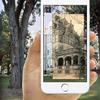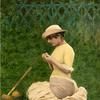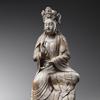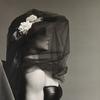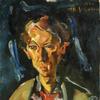Traveling Retrospective Examines the Life and Work of 19th-Century 'Art Sensation' John Leslie Breck
- May 22, 2022 16:21
John Leslie Breck: American Impressionist, an exhibition showcasing more than 70 works by one of the first American artists to introduce Impressionism to the United States, wraps up its tour this summer and is covered in a richly-illustrated exhibition catalogue. The exhibition — the first ever organized by a museum to be dedicated to works by John Leslie Breck (1860–1899) — debuted last fall at The Mint Museum in Charlotte, traveled to the Dixon Gallery and Gardens in Memphis, and ends its run at the Figge Art Museum in Davenport, Iowa, May 28 to August 28, 2022.
Breck was born at sea off Hong Kong in 1860. After training in the United States, Germany, and France, he visited the town of Giverny, France for the first time with a small group of colleagues in 1887. He soon befriended Claude Monet and his family, helped lay the groundwork for Giverny to become an artist’s colony, and began his conversion to Impressionism.
During a quick trip back to the United States in 1890-91, Breck was among the first to exhibit his new Impressionist paintings here and to use the style to depict the American landscape. He soon became known as one of the leaders of the movement in this country—a reputation that was enhanced by the work he did on a second trip to Giverny in 1891, a series of increasingly well-received exhibitions in Boston in the mid-1890s, and his final series of paintings of Venice after a trip there in 1897.
Reviewing Breck’s first solo exhibition at the St. Botolph Club in 1891, the critic for the Boston Transcript called it “the art sensation of the season,” going on to say that “almost everybody in town has visited the exhibition and almost everybody is discussing it.” Two years later, another critic reflecting on the impact of this 1891 exhibition wrote that “a fierce controversy at once arose between the champions of the old…and the new… landscape schools. …Mr. Breck was at once recognized, by friend and foe, to be the American head [of the latter].”
Upon Breck’s suicide in 1899, his colleague John Henry Twachtman, himself one of Impressionism’s American leaders, called Breck “a great genius” and the artist who had “started a new school of painting in America.” Despite the high regard in which Breck was ultimately held in Boston art circles and by his contemporaries at the end of his life, since his passing he largely has flown under the art historical radar. This is the first large scale, museum organized retrospective of Breck’s work since his memorial exhibition in 1899. It features more than seventy of his finest paintings, many of which have not been on public view since his death, as well as several related works by his colleagues. This is a rare opportunity to see for the first time so many of Breck’s groundbreaking paintings gathered in one place, to dive into the lush world of his landscapes, to reflect upon your own relationship with the natural world, and to consider anew Breck’s rich legacy
Drawn from public and private collections, as well as the acclaimed Terra Foundation collection of American art, many of the works have not been on public view in more than a century. In addition to Breck’s landscape-inspired works, the exhibition highlights his exploration of new styles and approaches to painting in the years before his early death at the age of 38. More than 10 related paintings by Breck’s French and American Impressionist colleagues, including Theodore Robinson, Willard Metcalf, and Lila Cabot Perry, are also featured in the exhibition.
The exhibition was inspired by The Mint Museum’s acquisition of Breck’s canvas Suzanne Hoschedé-Monet Sewing. “The importance of John Leslie Breck’s works and his introduction of French Impressionism to an American audience has largely gone unrecognized but is an important part of American art history,” says Todd A. Herman, PhD, president and CEO of The Mint Museum. “Through dedicated research and work by the staff at the Mint, Breck and his beautiful paintings will be brought back into the conversation of American art.”
A 208-page, fully illustrated exhibition catalogue is available. Jonathan Stuhlman, senior curator of American art at The Mint Museum collaborated with leading Breck scholars Royal Leith and Jeffrey Brown to bring together Breck’s finest paintings, as well as to create the first ever monograph produced about the artist, which also includes contributions from Erica Hirshler, PhD, and Katherine Bourguignon, PhD.





100x100_c.jpg)


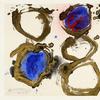

![Peter Paul Rubens (Flemish, 1577–1640), After Titian (Tiziano Vecelli) (Italian [Venetian], c. 1488–1576), Rape of Europa, 1628–29. Oil on canvas, 71 7/8 x 79 3/8 in. Peter Paul Rubens (Flemish, 1577–1640), After Titian (Tiziano Vecelli) (Italian [Venetian], c. 1488–1576), Rape of Europa, 1628–29. Oil on canvas, 71 7/8 x 79 3/8 in.](/images/c/e2/2e/Jan20_Rape_of_Europa100x100_c.jpg)

